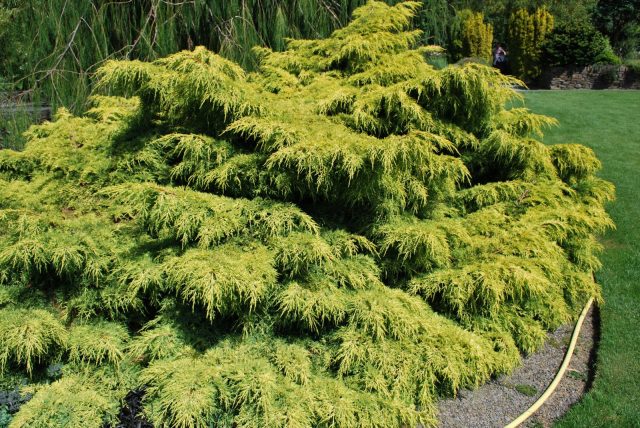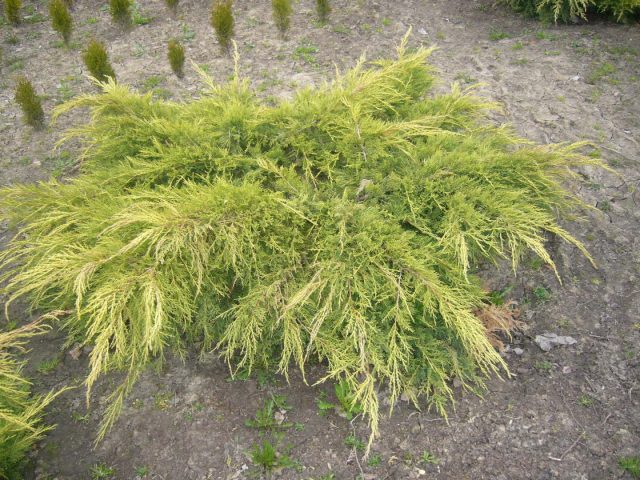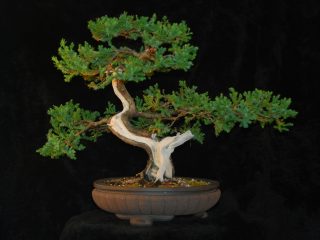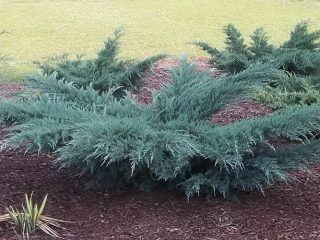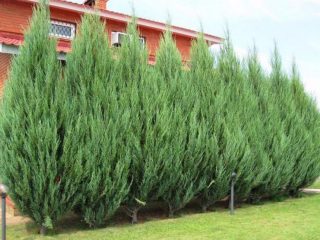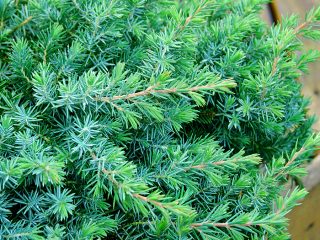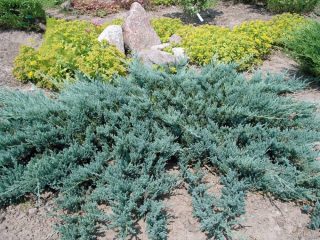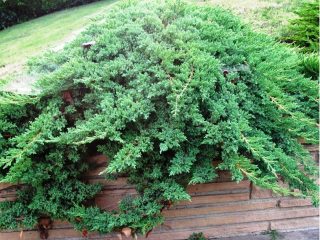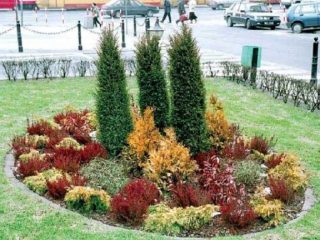Content
A low-growing representative of the Cypress family, Gold Star juniper (Golden Star) was created by hybridizing Cossack and Chinese common juniper. It is distinguished by its unusual crown shape and decorative coloring of the needles. The plant was bred specifically for landscape decoration and is widely used in design techniques as a ground cover plant.
Description of Juniperus chinensis Goldstar
Gold Star Juniper is an evergreen shrub with horizontally growing side stems. The central shoots are more upright, along the edge of the crown they are creeping, the habit visually resembles the shape of a star. The average Gold Star juniper reaches a height of up to 60 cm, the length of the branches is 1.5 m or more. Unlike representatives of the species, it has a stamp, which allows Gold Star juniper to be grown by pruning as a low tree; drooping side shoots give the plant a weeping shape.
The culture grows slowly, the annual growth is within 5 cm in width and 1.5 cm in height.Upon reaching 7 years of age, growth stops and the plant is considered an adult. The size of the shrub depends on the location of the growing season: in an open area they are smaller than near a pond with periodic shading. A plant with an average level of drought resistance; at high temperatures and moisture deficiency, the growing season slows down significantly.
The low-growing shrub is highly frost-resistant. Tolerates temperature drops down to -280 C, making it attractive for growing in temperate climates. The perennial can grow in one place for more than 60 years; due to its slow growth, it does not require constant crown formation.
The description and photo of Gold Star juniper posted above will help you get a general idea of the culture:
- The branches are of medium size, 4 cm in diameter near the trunk, tapering towards the top point. The side shoots are of a creeping type, the upper branches fit tightly to the lower ones, without forming gaps.
- The bark of perennial shoots is light green with a brown tint, young shoots are closer to dark beige. The surface is uneven, prone to peeling.
- The needles are of different types, needle-shaped near the stem, scaly towards the end of the branches, collected in whorls, secreting insecticides. The color is uneven, dark green closer to the center of the bush, and bright yellow at the edges. In autumn it acquires a uniform light brown color.
- The fruits are dark, spherical, with a high concentration of essential oils. The surface is glossy with a bluish coating, the seeds are oblong, 3 pcs. in a bump. The formation of ovaries is insignificant and not every year.
- The root system is fibrous, superficial, the root circle is within 40 cm.
Juniper Gold Star in landscape design
Due to its unusual color and unpretentiousness to weather conditions, Golden Star juniper is widely used in the Moscow region, Central and European parts of Russia. It is used to decorate the landscape of recreation areas, flower beds in front of the facade of administrative buildings, and personal plots. As a clear example, the photo shows the use of Gold Star juniper in garden design.
The low-growing shrub is used in a group composition and as an independent single plant. It harmonizes well with dwarf coniferous trees and flowering plants. Used as an exotic accent in the central part of the flower bed. The Gold Star juniper planted at the top of the alpine hill creates the impression of a flowing golden cascade. Used in a design technique to create:
- accent near an unusual stone structure in a rock garden;
- coastal zone near artificial reservoirs;
- background ridges;
- aesthetic appearance on rocky slopes within the city;
- imitation of an alley along a garden path.
Juniper (juniperus media gold star) can be found planted around a gazebo or summer veranda.
Planting and caring for Gold Star juniper
Gold Star juniper is unpretentious to soil composition and can grow in soil with a high concentration of salts. But a prerequisite is that the soil must be loose, if possible, fertile, without close contact with groundwater.
When planting and caring for juniper medium Gold Star, take into account that this is a light-loving plant, but with periodic shading it feels comfortable. However, in the shade of tall trees with a dense crown, it loses its decorative effect. The needles become smaller, the branches become elongated, the colors become faded, and dry areas may be observed.
The plant has average drought resistance. If the shrub grows in an area open to the sun, care must be taken to ensure that the root layer of the soil does not dry out.
Preparing seedlings and planting area
You can grow a seedling yourself or purchase a ready-made one. The main requirement for planting material is a formed, healthy root without dry areas, the bark is smooth, light green, without damage, the obligatory presence of needles on the branches. Before placing it in a permanent place, the root system is immersed in a manganese solution for 2 hours. Then, so that the root develops better, put it in a growth stimulator for 40 minutes.
The site and planting hole are prepared 2 weeks before planting. The area is dug up and plant roots are removed. To lighten the soil and provide drainage, add peat, compost and coarse sand. The hole is prepared taking into account that it is 15 cm wider than the root. The height is determined according to the scheme - the length of the root to the neck plus 20 cm. Approximately, the hole is 50-60 cm wide and about 70 cm deep.
Landing rules
Before planting Gold Star juniper, prepare a mixture of turf layer, sand, peat, and compost in equal proportions. Add 100 g per 10 kg of dolomite flour. Sequence of work:
- A layer of gravel is poured onto the bottom of the hole; it will act as drainage.
- The mixture is divided into 2 parts, half of the nutrient soil is poured onto the drainage.
- The seedling is placed in the center, vertically.
- Separate the roots so that they do not intertwine.
- Cover with the remaining mixture.
Water and mulch the root circle with peat or straw. The distance between Gold Star juniper bushes is determined at will, but not less than 1 m. The bush is spreading and does not tolerate planting density well.
Watering and fertilizing
Juniper medium Gold Star cannot grow in severe drought, but waterlogging of the root can be disastrous for it. After planting, the plant is watered for 60 days at the root, every evening with a small volume.
The Gold Star juniper variety responds well to sprinkling; irrigation every 1 day, in the morning, is recommended. The plant is fed once a year, in the spring, until it is 2 years old. Juniper does not require fertilization afterwards.
Mulching and loosening
Immediately after placing the juniper in the ground, the root circle is mulched with straw, freshly cut grass, peat, straw or chopped tree bark. The composition of the shelter is not important, the main thing is that it is functional and retains moisture well. In the fall, the mulch is renewed. Loosening is carried out on young junipers in spring and autumn. Then the soil is not loosened, the mulch retains moisture, the top layer does not dry out, weeds They do not grow under a dense crown.
Trimming and shaping
Pruning of Gold Star juniper is carried out in the spring; it is of a cosmetic nature. Remove frozen stems and dry areas. If the plant has overwintered without loss, the health procedure is not performed.
The Gold Star juniper bush is formed based on the design decision; the length of the branches is shortened in early spring, when the plant is dormant. Gold Star juniper forms a standard and can be grown as a small tree. Within 5 years, the lower branches are cut off, you can get a ball shape or a weeping version. The hybrid has good survival rate on the trunk of tall-growing species; you can use the grafting method and obtain the desired tree shape.
Preparing for winter
Frost-resistant Gold Star juniper does not require special preparation for the winter period. Increase the layer of mulch and carry out water-recharging irrigation. Before mulching, young seedlings are hilled up and covered with a layer of straw on top. To prevent branches from breaking under the weight of snow, they are tied into a bundle and covered with spruce branches or dry leaves. In winter they are covered with snow.
Propagation of juniper Pfitzeriana Goldstar
Juniper medium Pfitzeriana Gold Star is propagated in several ways:
- layering from lower branches;
- by cuttings, use shoots after 2 years of growth;
- grafting:
- seeds.
Diseases and pests of juniper Golden Star
Juniper horizontal Gold Star does not get sick without nearby fruit trees. There are few parasitic insects on the crop, these include:
- Shield. The pest appears if the air humidity is low, and with constant sprinkling the insect is absent. If a pest is detected, treat the bush with a solution of laundry soap or insecticides.
- Juniper sawfly. The insect and its larvae are eliminated with the drug “Karbofos”.
- Aphid. The most common pest of juniper, it is brought by ants to get rid of the parasite and destroy a nearby anthill. Places where aphid colonies accumulate are cut off and removed from the site.
For preventive purposes, in spring and autumn, bushes are treated with copper sulfate.
Conclusion
Gold Star Juniper is a perennial evergreen. The shrub is of short stature, frost-resistant, with strong immunity to fungal and bacterial infection, and is unpretentious in care. Used to decorate park areas, personal plots and gardens. They are grown throughout Russia with warm and temperate climates.
